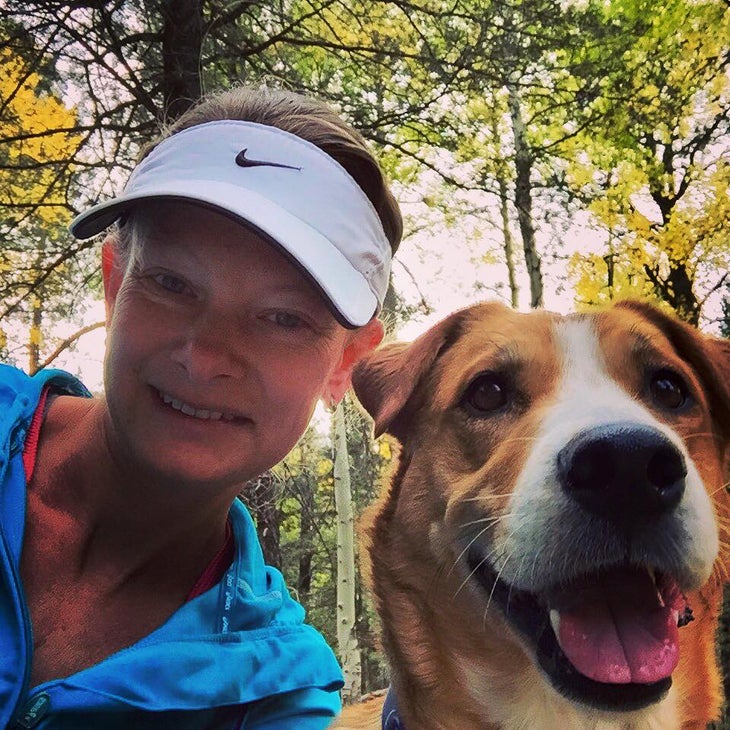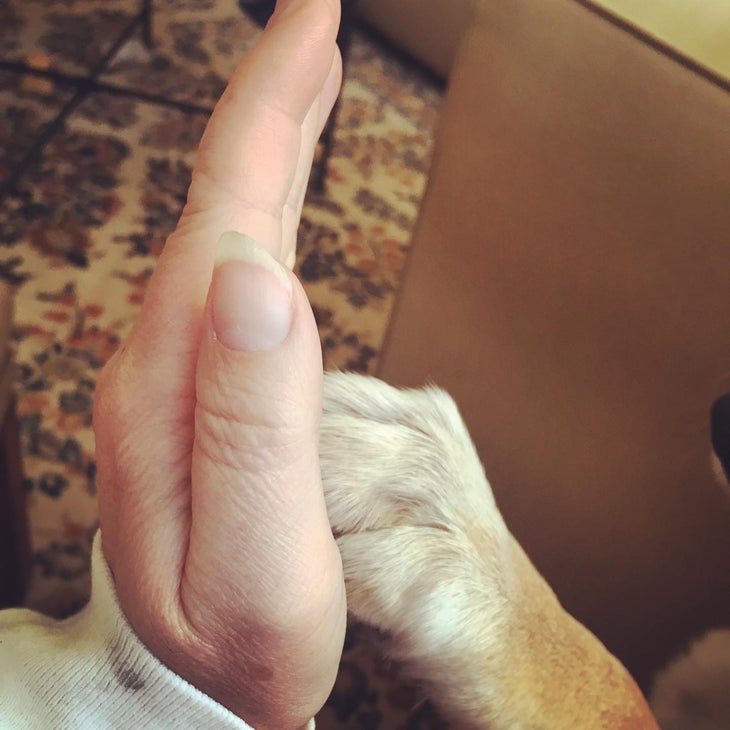Products You May Like
Get access to everything we publish when you
sign up for Outside+.
I had the same vision as every other runner when I adopted my first dog. I’d bring him home, put on my running shoes, and we’d share endless miles on the trails together for years to come.
This, however, is not that story.
I adopted Marley in August 2010, in the midst of training for the Chicago Marathon. He had spent his first two-ish years of life as a stray, roaming the Native American lands of Northern Arizona before he ended up in a shelter in Flagstaff, where I had recently moved. In this new-to-me mountain town, most people seemed to have three staples in their lives: a puffy jacket, a Subaru, and a dog. The dog was my first step toward assimilation.
“Should I take the ‘Adopt me’ vest off of him?” a volunteer asked not more than five minutes after I sat with Marley on the sidewalk outside the PetSmart, his chin resting on my lap like we had known each other forever.
“Yes please,” I responded, without hesitation or a moment of consideration. He had my heart from the second we spotted each other.

Marley had never lived in a house before. The first night in his new home, he tried to dig a sleeping den into the carpet, unsure of what that new cozy bed on the floor was for. He had never seen a dog toy either and for the first year, at least, confused items like cell phones and remote controls with bones and squeakers. He chewed the power cord off my treadmill not once, but twice.
Back then, Marley was also wrapping up chemotherapy from his first bout of cancer (a second bout followed a year later, which he also overcame after chemo). He didn’t reveal his full personality and energy level until he received a clean bill of health. Shortly after that, desperate to funnel his new-found vigor, I started introducing him to my other love: running.
But Marley had no interest. To him, the great outdoors was meant for many of activities he cherished—and that did not include running. It was where he greeted every person and every dog who crossed our path, without fail, certain that one and all were meant to be his friends. Outside was for tracking all the bunnies and squirrels up the trees. It was for marking all the territory and pointing his snout in the air and sniffing all the scents. Going outside was a full sensory experience, one that he loved beyond measure every day of his life. Why would anybody intentionally rush it?
I persisted, however, still hanging on to the idea that he’d be my running partner like I’d dreamed. He just needed time and practice, I thought. So my friend Christina and I took him to the single-track trails near our neighborhood one morning, thinking he probably would adapt with a little encouragement. About four miles in we noticed he was no longer with us. I turned around to find him lying under a tree, resting in the shade, chewing on a stick. We mostly walked the rest of the way home—he was perfectly happy to trot alongside me at a more leisurely pace.
When I left to go run the Chicago Marathon that October, my friend Karen watched Marley at her house. It’s appropriate to note that Karen London, Ph.D., is a certified applied animal behaviorist and professional dog trainer. And while she could not teach Marley to love running, she taught him the next best thing while I was away. She taught him to give high fives.
I came home from racing what would go down as my lifetime best marathon and Marley proudly welcomed me with a congratulatory high five. My heart just swelled. Maybe he wouldn’t join me in training, but for the next 12 years he gave me a high five every time I finished a run. My biggest fan, my most loyal supporter. A long run, an easy run, a track workout, a good run or a lousy one—it didn’t matter. Marley gave high fives no matter what, as soon as I walked through the door.

As the years progressed, Marley found his sweet spot on the single track: hiking. His happy place was the Inner Basin Trail, a series of gentle switchbacks through Aspen groves beginning in Lockett Meadow, considered by nearly everybody here as the gem of Flagstaff. The trail leads up to a valley surrounded by the slopes of the San Francisco Peaks, actually the remains of an extinct volcano, another place near-and-dear to all the locals. We’d make our way to the Inner Basin and, if you asked, he’d give a high five after the climb, enjoying a few treats and a little rest before heading back down the mountain.
In the past year, Marley continued insisting on his daily walk, even as arthritis and other old-man ailments slowed him down. We’d stroll around the neighborhood and most days he’d insist on the long route, still greeting friends along the way. When we’d finish, he’d lie down on the kitchen rug to give his high five with no less spirit, just less mobility to do it from a sitting position. On those final outings from the front door, I relished watching his floppy ears bounce on the occasions he had the energy to prance by my side, like he used to.
The final time I took out his leash two weeks ago, it was the first time he’d ever resisted. No longer able to get up without assistance, unable to balance well on all fours, his sad eyes looked into mine and I knew. The very thing that had always made him most joyful had become an impossible endeavor.
Before I said my last goodbye that night, between sobs, I thanked Marley for everything. For being my best friend. For teaching me to slow down, make friends, and enjoy the scenery. For showing me it’s better to stick to what you love to do instead of wasting time on what you don’t. I thanked him for teaching me how to accept somebody for who they are instead of pressuring them to be somebody they’re not. And, most of all, I thanked Marley for teaching me about unconditional love, shown one high five at a time.
Rest easy, my sweet Marley. Happy trails and high fives to you forever, my best boy.
